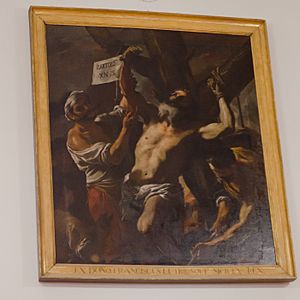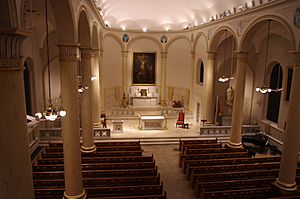Basilica of St. Joseph Proto-Cathedral facts for kids
Quick facts for kids Basilica of St. Joseph Proto-Cathedral |
|
|---|---|

The outside of the Proto-Cathedral
|
|
| General information | |
| Architectural style | Greek Revival |
| Town or city | Bardstown, Kentucky |
| Country | United States |
| Completed | 1823 |
| Client | Roman Catholic Archdiocese of New York |
| Design and construction | |
| Architect | John Rogers of Baltimore. |
The Basilica of Saint Joseph Proto-Cathedral is a historic Catholic church in Bardstown, Kentucky. It was the first cathedral for the area, which is now part of the Roman Catholic Archdiocese of Louisville. The term "proto-cathedral" means it was the original cathedral before the main church center, or see, moved to a different city.
Contents
Building the Cathedral
Construction on this beautiful church began a long time ago. The first stone, called the cornerstone, was laid on July 16, 1816. The builders used local materials found right there in Kentucky to build the church. The main architect was a man named John Rogers.
By 1819, the building was ready enough to hold church services, called Mass. The inside was completely finished by 1823.
Gifts from Europe
Many of the amazing paintings and decorations inside the church were gifts. They came from important people like Pope Leo XII and King Louis-Philippe of France. The king of France sent paintings by famous artists like Murillo and Van Dyck. He also sent special clothing for priests, called vestments, that were embroidered by the queen and her court.
Art and a Famous Heist
The church is famous for its collection of classic paintings. Many were gifts from European royalty.
Paintings from King Louis
- The Crucifixion by Phillippe Van Bree
- Descent of the Holy Ghost by Van Eyck
- The Winged St. Mark by Van Dyck
- St. Peter in Chains by Van Dyck
- St. John the Baptist by Van Dyck
- The Coronation in Heaven of the Mother of God by Murillo
- The Annunciation by Van Eyck
- Teaching the Boys by an unknown artist
In 1952, a major art theft happened at the church. Thieves broke in at night and cut nine paintings right out of their frames. The F.B.I. searched for the stolen art and found the paintings in April 1953. Some were found in the trunk of a car in Chicago, and others had been sold in New York. Luckily, the paintings were still in good condition. They were returned to the church and put back on display in 1958.
Painting from King Francis I

Another famous painting in the church is The Martyrdom of St. Bartholomew by Mattia Preti. It was a gift from King Francis I of the Two Sicilies. For many years, the painting was not well cared for and was even painted over.
Later, art experts at the Getty Museum carefully studied and restored it. After two years of hard work, the painting looked like new again, showing its original beauty. It was returned to the church in 2002.
Why Is This Church Important?
This church holds a special place in American history. It was the first Catholic Cathedral built west of the Allegheny Mountains. Because of its importance, it was added to the National Register of Historic Places in 1974.
For a long time, no one knew where the original cornerstone from 1816 was. But in 1980, during repair work, workers discovered it!
In 2001, Pope John Paul II gave the church a special title, making it a minor basilica. This is a high honor for a church.
Daniel Rudd: A Voice for Change
A famous person connected to this church is Daniel Rudd. He was born into slavery in Bardstown in 1854 and was baptized in the Catholic church. After gaining his freedom, he moved to Ohio and became a journalist.
In 1885, Rudd started a newspaper called the American Catholic Tribune. It was the first national Catholic newspaper in the country owned and run by an African American. Rudd used his newspaper to speak out against unfair treatment and to promote the idea that the Catholic Church could help bring equality for African Americans.
History of the Diocese
In 1808, the Catholic Church created the Diocese of Bardstown. A diocese is an area managed by a bishop. This was the first inland diocese in the United States.
In 1841, the center of the diocese was moved from Bardstown to Louisville. The main cathedral then became the Cathedral of the Assumption in Louisville. That's why St. Joseph's is now called the "proto-cathedral"—it was the first one.
See also
 In Spanish: Basílica de San José (Bardstown) para niños
In Spanish: Basílica de San José (Bardstown) para niños


